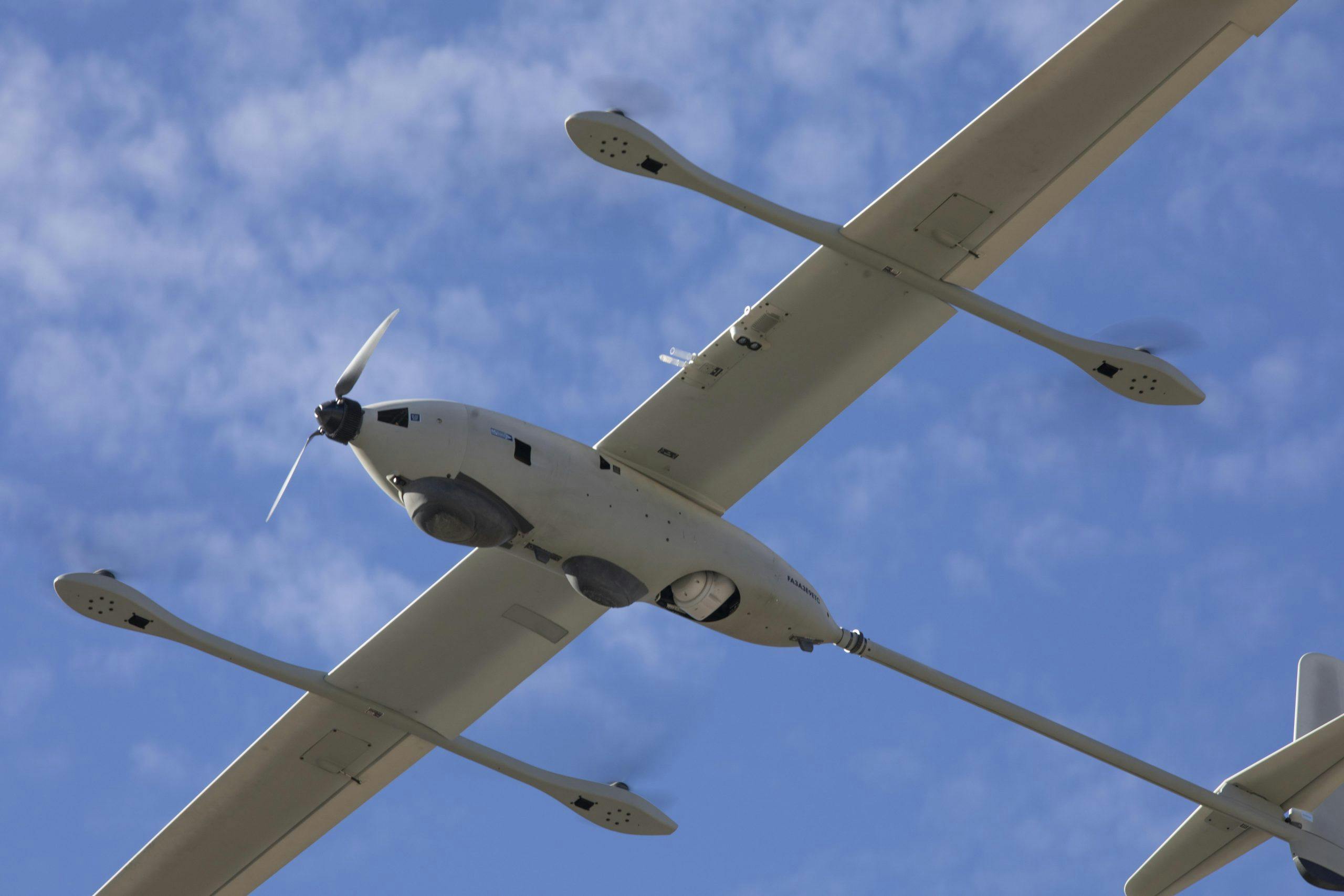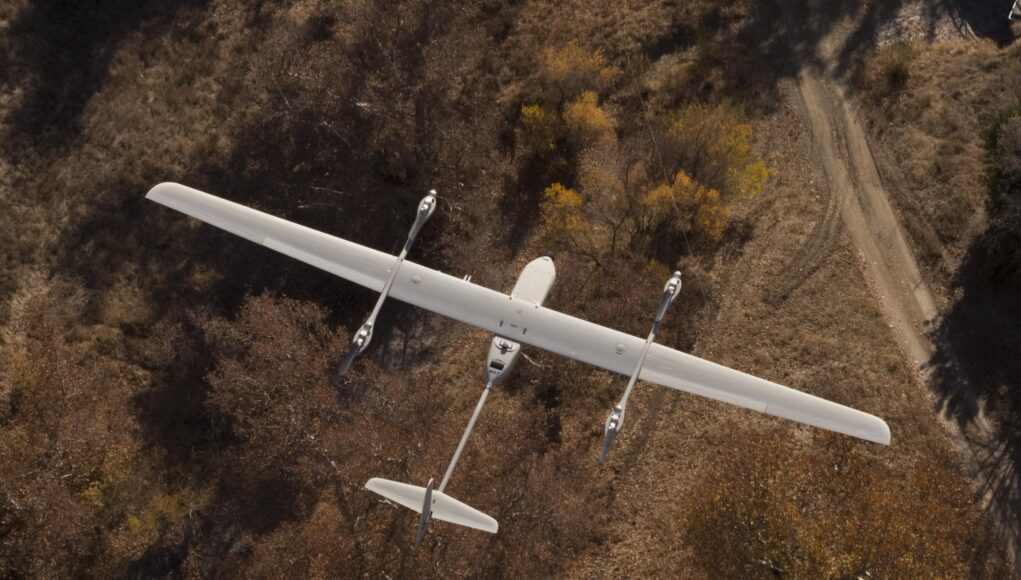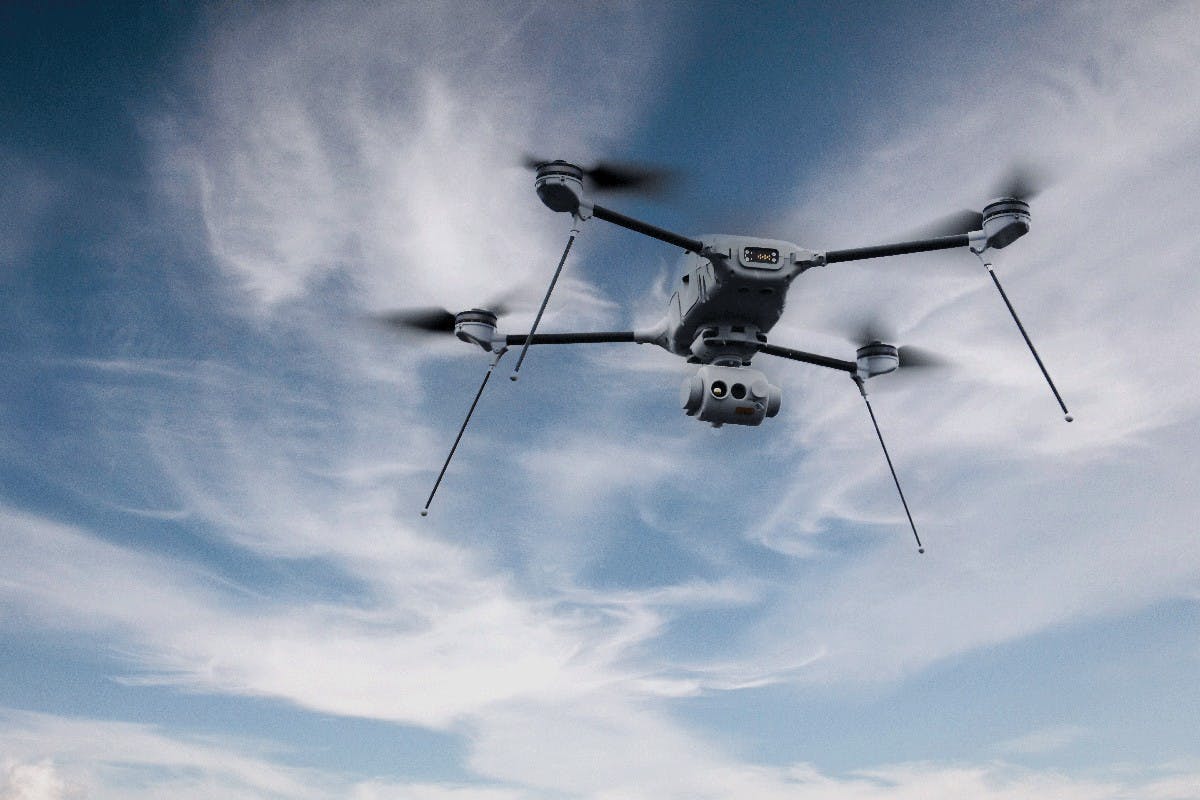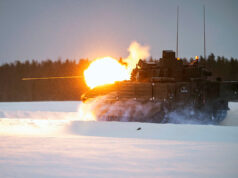A £129 million initial contract has been awarded by the Ministry Of Defence to deliver drones to the Armed Forces, of which 99 Stalker and 15 Indago models will be used by the British Army.
The Mini Uncrewed Air Systems (MUAS), produced by Lockheed Martin, will be used by British Army and Strategic Command for Intelligence, Surveillance, Target Acquisition and Reconnaissance (ISTAR) on the front line and deep into enemy territory.

According to a news release, the portable drone will be the Stalker, an operationally proven small, near-silent drone, that provides unprecedented long-endurance imaging capability in a variety of contested environments and is in use by Special Forces around the world. It weighs less than 20kg.
The packable drone – small enough to be carried in a backpack – is the Indago, which weighs less than 8kg and can be deployed in approximately two minutes.
“The project, signed with Defence Equipment & Support (DE&S), will solve the capability gap of previous DH3 and RAGGLE operational service drone schemes as well as enable the rapid advance of capabilities to react to demands and allow Lockheed Martin to scan the market for new technology.”
Brigadier Pete Drew, the Army’s Senior Responsible Owner for the programme, named TIQUILA, to deliver MUAS capability, was quoted as saying:
“TIQUILA will bring the next generation of remotely piloted air systems into service in the Army. It marks a significant milestone for the Land ISTAR programme, with TIQUILA being the first sensor to be integrated into the wider ISTAR system. It will speed up decision making and will make us more lethal, responsive and resilient as a force, underlining the Army’s commitment to delivering Future Soldier as set out in the integrated review.”
Delivery of the drones will start in March 2023 and full operational capability for four Future Soldier Batterys will be realised in 2026, you can read more on this here.














This can’t be right, where is the multi billion pound decade long contract to f**k around with Off the shelf solutions to give us the proper bespoke Gucci capability the army really needs 10 years too late
The British Army has a long tradition of this including Phoenix and Watchkeeper and I think it’s important we respect that legacy.
You can just go out and buy stuff with out at least a proper four letter abbreviation for it. 😀
They were right about speeding up decision making then.
I think it’s a little ironic our previous long drawn out committee driven process has actually enforced these sudden decisive decisions to be made. The crony prospective committee members will be so up in arms however about having their income actually spent on kit for the forces. Geez they might have to actually work for a living.
that’s the funniest thing I have heard in years… top marks Jim
Jim it is actually a decade long contract, other sites in the US are saying the total over 10 years is 159 indigos 4 drones ( rotor) and 105 stalker VXE30 fixed wing drones. So it may be the numbers quotes by the army are what will be operationally available vs the total contract numbers ( I can’t imaging they have a long life).
The MOD quoted the bigger numbers in an announcement on Friday.
All are to be operational by the end of 2024. Presumably the rest won’t be used by the Army.
I can’t even find a spec for the Indigo 4s. The currently advertised one is Indigo 3. An article priced older Indigos at $25,000, which is what they look like. Broadly the same as the British Sky Mantis at about £20,000.
I did see an article probably on the LM website about the update to version 4 with increased aground performance. Think it’s in progress. I also read ( from the MoD I think) how this was a great success for British Industry though no explanation as to quite how.
Over £1 million per drone then? Meanwhile in Ukraine they are using civilian ones costing from £500 > £5000 with incredible results.
Genuine question but am I missing something here regarding the capability these new drones offer? Is the loiter time much greater or something vs standard off the shelf drone?
I imagine the video/datalink etc are much improved but over £1 million seems crazy for a man portable drone.
Hi see my post, there are reports the total order is for 264 drones.
Ukrainian sources I read pretty much said that a drone’s expected life cycle is 5 missions and thus it was impossible to simply rely on Military standard drones and thus drones of every kind are being sought with many larger ones being checked, upgraded and/or updated for specific military roles. I suspect we would go the same way in a conflict with military standard ones being used as selectively as possible. Resistance to interference will be more vital in some environments than others.
While Ukraine’s use of drones is remarkable and great, they don’t last long. Not to mention the security concerns if they are Chinese-made (no matter how DJI protest, they are at the beck and call of Xinnie the Pooh).
Ukraine make do.
Anyone else feel there has been a serious proliferation of UAV projects for the British Armed Forces which seems to either lead to demonstrators that don’t go anywhere or a classic overlap of similar roles being fulfilled by similar systems all operating in their own silo’s of development and use?
I suppose this is at least a decision given the urgency of the problem. However, could someone please explain to me how once again the UK has decided to withdraw itself from one of the key critical strategic capabilities for the 21st Century?
Is it lack of funding and risk adversion preventing UK companies developing such, or is it a lack or foresight/strategic thought from civil servants and politicians.
I’m in the civil drone business and can see lots of American, Chinese, French, Estonian, Swiss etc. involvement – but very little UK effort.
Sadly our nation is fixated with the idea of the service industry economy, actual high quality hi tec manufacturing is just not something that’s been supported and in reality the sad truth is the Army needed this order and we could not really wait for our own industrial capabilities to catch up, also it’s really a small niche order that would not sustain an industrial base.
From a defence point of view, I think the industrial strategy needs to focus on the industry and defence manufacturing we still have:
1) complex warships
2) nuclear submarine
3) rotor
4) fix wing aviation
5) advanced munitions
6) sensors
its a shame incompetence procurement and non existent industrial strategies have cost us our our armoured vehicle manufacturing as we have a big enough army that could have kept it going, if the government ( of all types over many decades) had with the army a clear procurement timetable instead of the boom bust cycle that’s killed it off. Add up the money ( many many Billions) the army has pissed away on procurements over the last 20 years to get nothing much at all…..that could have as part of a proper military industrial strategy worked.
What our government has forgotten is that for a major power, defence is about a whole military industrial complex…….
..very true, very sad. Agreed. Missed opportunity like so many others. I’m off to flip some burgers….
The U.K. is the 11th largest manufacturing economy by value. We build really high-etc, high-value items, rather than cheap low cost things like washing machines.
Hi Sean, indeed, but and this is big you need to have a balanced economy of high and low tec manufacturing. The high tec is still dependent on metal bashing manufacturering.
you need to be good at all ends of the manufacturing spectrum. After all most of the population need low end manufactured products more than high end tec and that means money leaves. Also not everyone can be employed in high end manufacturing, for a stable society you need well paid wealth producing jobs for all abilities in you society, otherwise you end up with an underclass that is not only unproductive, but costs society a fortune and reduces social cohesion ( one thing the victorians realised, you have to have everyone making or doing something).
But my key point was on strategically important industries, that includes things like steel, chip manufacturing as well as specific end products like ships and rotors.
As a great easy example, my top of the range British built cooker ( I’m talking, practically able to cook dinner for you high end) was delayed for 5 months because a of few basic parts from china were not available.
If another nation is producing something we must have, we had better be dammed sure they are going to be friends for the foreseeable ( big old note, there are no long term friends in geopolitics) or we can get the capability up and running easily.
Here, here.
Our economy has low-end manufacturing too, it comes down to a case by case basis whether it makes more financial sense for a component to be made in the U.K. or not. Now obviously that is just a company looking at its bottom line, rather than considering national resilience or strategic imperatives.
However, given the sheer complexity of the modern world, no country can be completely independent of others. From mining materials, refining them, then using them to make parts, to then combining the parts in machinery, you’re looking at dozens of countries being involved.
Re your cooker, why were those basic parts from China not available? Maybe the material needed from a third country was not available. Or the refinery in a fourth country had no spare capacity to refine that material. If the vessels/aircraft from a fifth country were not available. Maybe it was the packaging for these parts – perhaps from a sixth country?
It’s possible that the cooker manufacturer could have sourced the parts, if they were not bespoke, from another source but simply chose not to for convenience/cost reasons.
In wartime global trade will continue. The question is whether what we require to continuing prosecuting that war is available or not. It could be we require parts or materials from our opponent in which case they are unlikely to be available – though during WW1 the German chemical industry continued to supply the dye for British Army uniforms…
Or the parts/materials required may be from a neutral country which decides to put an export ban on these to all belligerents.
The pandemic was analogous situation to wartime. In early 2020, every country (friend and foe) was scrambling to buy up every ventilator on the market.
The U.K. realised it needed more, and the Cabinet Office put out contracts for the development of new ventilator designs to be built using readily available off-the-shelf parts. That would ordinarily be a 4 year project, and my company – like others – were able to complete and build first batches in under 4 months. But you can be sure if large scale production had begun, ultimately these common off-the-shelf parts would have run out too.
There should be a certain amount of strategic planning for parts, but it has to be targeted. While it’s good to have native chip manufacturing, unless the leading manufacturers such as TSMC decided it’s economically advantageous to onshore production here, then it’s unlikely to be cutting edge. (It’s costing TSMC over $40 billion to build a new chip plant in Arizona and it’s not getting any of the $52 billion that the US Gov is throwing at US companies in subsidies for chip fabrication.)
We need to accept a certain reliance upon our allies – and them on us – for materials and parts during future conflicts. Given how generous countries have been towards Ukraine, I’m pretty sure our friends will be happy to continue to sell to us.
The one caveat I would add… Both the pandemic and Ukraine War have shown the importance of holding stockpiles of items that will be consumed at a high rate (eg; PPE to munitions). The cost-reducing “Just In Time (JIT)” delivery philosophy with minimised warehousing has NO resilience whatsoever in times of disruption. Stock-piles buys you time to find new sources for parts or materials if your supply change is disrupted.
Ye to all of that but in the end to ensure you have a stable state you really need a few things in place structurally:
1) a positive or at least neutral balance of trade, and our balance of trade has been in a negative figure since 1997. Whatever else a Nation cannot indefinitely spend more wealth than it produces.
2) you have to secure that which is strategically important (in both manufacturing and resources) If your nation cannot do without it you must ensure the have supplies that “Cannot be held at risk”. All major powers wars have been won and lost on this simple truth.
3) you have to maintain industries to employ your entire working population. Even if it’s making widgets that could be made cheaply by a neo slave population in china. Not everyone can work in high tec industries, be a creative, banker or professional. If you don’t manage your economy to ensure the opportunity for universal economic activity, your culture will end up suffering a collapse.
4) reasonable distribution of wealth, not in the communist way, but in a way that manages social stress.
Our problem is that we have a few gaping holes.
1)we don’t have a positive trade balance
2)we have insecurities in regards to a large amount of important resources and products.
3) we have not ensured we have an industrial/economic base that provides secure work for our whole working population
4) our wealth distribution is seen as inappropriate ( and for this point perception is everything).
1) Yes any nation should strive for a negative balance of trade, though obviously not attainable by all. But trade covers both goods and services, the U.K. makes a fortunate selling its professional services globally.
2) Well we can’t without going to war against nations who are currently allied with us. As regards to things like rare-metals, the Chinese already dominate the market, either owning mining rights in third countries or doing most of the refining. This needs to be a collective effort by the West to ensure these, and other resources are available. I doubt even the USA could do this on its own.
(I’ve always maintained that free-trade should have been a condition of NATO membership. It would strengthen the military alliance and allow alliance-wide strategic resource planning.)
3) No we don’t, we’ve never had full employment previously. We’ve always had an unemployable underclass, it’s just that these days we’re more civilised and don’t let them starve/ turn to crime. We currently have a huge number of vacancies in the U.K. jobs market, in theory enough for 100% employment. But fact is, some people are incapable of holding down even the most basic job.
4) Our wealth distribution is pretty good, if you want to see gross inequality go see the shanty towns outside Oakland, California or most rural places in the middle-east away from their glitzy capitals.
The great inequality in the U.K. is housing, with us returning to the Victorian era where the majority rent and a small privileged landlord class control the housing stock. This is simply due to successive governments supporting the housing bubble because they know they’ll lose votes if home owners perceive a drop in the theoretical market value of their house.
Hi Sean, unfortunately when I quoted the trade deficit it’s the trade, industry, resource and service industries combined. So although we have a large service industry surplus it’s far outweighed by the trade deficit, we buy far more stuff than money we make as a nation and we have been since 1997. Now a nation can manage short term deficits and most nations go through positive and negative years but the UK had been in deficit for 25 years. That’s one of the really significant drags on our economy as we are now. The deficit has widened as well from 14.5ish billion in 1998 to between 20-35billion in most recent years.
This ability to close a manufacturing deficit is pretty much impossible ( nations need more stuff than they do services). Also the illusion of the high tec industrial strategy does not work either, high tec industries are based around wider industrial success..you grow your industrial base from the low tec to medium tec to high tec….so there is nothing that will stop China out competing any western high tec industrial strategy…the fundamentals of why China out competed western low/medium tec industries is still in play ( cheap workforce and massive currency devaluation). The west does have to think of a strategic approach to how it will manage this..it cannot stay debt to China.
Wealth distribution is unfortunately very much about perception In both difference as well as security. Unfortunately we have a problem with very high wages in groups such as CEO and Banking which create a cognitive dissonance around wealth ( even footballers do this).
Jobs market wise we have a very high number of economically inactive individuals in our society. This is partially a social construct. We are not eccomically active until 18-21 and become inactive at 66. That means we are all inactive for a great deal or our lives. So we only have 16.5 million Economically active individuals employed that’s very low. If you take the Victorian world almost everyone was considered economically active from 8-10 years old until death, not saying it’s a good thing but we now live in different reality and we have to somehow ensure national stability with such low levels of economic activity by making sure every adult is working to the maximum of their ability and is as productive as possible.
Before worrying losing sleep over the UK’s trade deficit I’d consider that;
(a) The USA has been running a trade deficit for over a decade longer than us
(b) Out trade deficit is £18 billion. It sounds a lot until you consider that it’s against a GDP of £2.2 trillion. In other words, the trade deficit is 0.008% of GDP.
China offered cheap labour, which is why items like Apple iPhones which are labour intensive are made there whereas heavily automated manufacturing, such as cars as still done in Europe. However companies like Apple are relocating manufacturing I got from China to India and Vietnam due to the rising labour costs and increasingly draconian measures in China.
For all of China’s low-tech industrial base, it cannot match the die-levels used by the world’s leading semiconductor manufacturers in Taiwan. We know from all the industrial espionage over the years that while China can manufacture Western technology when it has access to it, it is still far behind in developing its own technology. This will always be the case in an authoritarian communist regime where personal excellence and innovation is contrary to the political principles upon which it is based. The ideology doomed the USSR and it will doom the CCP too.
There’s no cognitive dissonance around CEOs or Footballers being paid high salaries IF that is their true market value. I doubt anyone would object to Musk’s salary as CEO for creating SpaceX, or turning around the fortunes of Tesla. However he should be fired as CEO of Twitter for the mess he’s made there.
The problem is when failure is rewarded, when an officer or director of a company immediately waltzes into another equivalent job after having wrecked a company.
It doesn’t matter how many years you work, it’s what you achieve in that time.
Too many poor managers depended on employee presenteeism over trying to properly evaluate individual’s performance: which is harder work. Their world was turned on its head, during the pandemic, when they could no-longer ‘see’ if employees were at their desk from 9am to 5pm. The irony was that productivity increased as people worked from home.
The same goes for a person’s career. As it is, our current recruitment crisis is due to large numbers of people in their 50’s during the pandemic re-evaluating their priorities in life AND realising they already had enough savings to retire early. Generally these are people who have achieved in their careers and received corresponding remuneration.
Better we have people like these, than journeymen who do the same unremarkable job everyday for decades with no self-improvement or advancement.
What you propose sounds like turning the U.K. into a work-camp. With everyone working until they drop dead of old-age at their desk/lathe/workplace. That will simply see the brightest and best leave for other less authoritarian countries.
Exactly. Well said.
As per usual we wait for others to take the risks and prove the technology before our major companies get interested. We have a similar situation in the Space Industry the expertise is there, we have many smaller companies involved but a fraction of the investment that other Countries put in a third of what the French do for example in that sector or the Germans and the idea that reducing taxes to Bankers for example will solve that problem is delusional. And yet our companies are doing wonders creating a Space Industry here more despite the Govt rather due to its enlightened thinking and it’s pretty much the same with other sectors Green for example, little Govt focused investment like the French while larger incumbent Companies unlike their German competitors willing to speculate on new ideas and technology until it has matured. How different to Britain during the great days of its expansion.
Well, the crooks are in charge and I don’t think they actually care an iota about the country; what care they do show is for the perception required to keep them in power.
They just care about enriching themselves and their mates.
…yes i can see the space industry is no wtrying with its incubator events and the like, but truth be told we were stuffed in the1960s after the Black Night era, and then the EU thing stopped any real UK industry. If the UK wants a space industry then it is going to have to commit more.
Strange as I don’t recall any spaceports in France or Germany… yet there are 7 proposed/in-development currently.
Personally I think private-sector entrepreneurs and innovators have a better idea or what is required to build an industrial sector than Whitehall civil-servants and politicians. We’ve seen in how private-sector SpaceX has run rings around the public-sector, NASA and ESA, in the development of new rockets. While reusable Falcon 9s regularly clock-up dozen of launches each, the next version of ESA’s Ariane is still only good for one launch and NASA’s ridiculous SLS is 80’s technology and uses old space-shuttle engines pinched from museum exhibits.
France has a MASSIVE spaceport that dwarfs anything anything the UK, and its been active for decades.
France HAS a spaceport in its a French Guiana colony in South America. It’s where the ridiculous Ariane rockets are launched from.
As I said, there are NO spaceports in France.
I hate to break it to you Sean, but French Guiana? That’s a part of France. It’s also much better situated for launches than any UK spaceport, which is why our ones are generally aimed at nice, small sat launches into SSO polar orbits.
It’s also a massive spaceport capable of launching way more than every prospective UK spaceport combined (oh and never mind the fact that no UK spaceport has actually made an attempted, let alone successful launch).
Oh and “ridiculous Ariane rockets” are you trying to be a parody? Lets be real here, the BIGGEST launch system thats planned (Empahise planned, not actually launched yet) from the UK is Launcher One, which can put about 500kg into LEO. Ariane meanwhile launched the James Webb Telescope, a Six tonne behemoth to the L2 point.
Let’s just quickly recap:
Launcher One 500kg to LEO (2,000km above the earth max)
Ariane: 6t to L2 (1.5million km from the earth),
Yeah France claims it’s part of France, doesn’t stop it being a ruse to old onto its old colonial empire. It’s as ridiculous as refusing Kenya independence and instead renaming it ‘Kenya-shire’ and claiming it to be part of England.
France only built it there after they lost access to their previous launch site in the Sahara when they were forced to abandon Algeria. (The Algerians being better at overthrowing imperialism than the Guianans.)
Yes Ariane is ridiculous – though admittedly not as ridiculous as the SLS. It is way more expensive to build than it ever needed to be because vanity required it to be man-rated even though there has never been an astronaut carrying capsule developed for it.
They’re finally dropping that vanity with Ariane 6, but it is still a single-use rocket. SpaceX, a small private venture, has booster rockets that have made over a dozen successful launches and returns. Yet the huge bureaucracy that is ESA and industry giant Airbus are still incapable of building a rocket that is reusable.
As a result, SpaceX’s offering is far cheaper and is coming to dominate that end of the launch market.
By comparison, in 2022 SpaceX had 53 Falcon 9 launches, compared to a mere 3 Ariane 5 launches… 😂
So yes, Ariane 5 and even 6 which is still in development are ridiculous and antiques.
But it’s downright ridiculous on your part to compare Ariane to LauncherOne. It’s like comparing a 747 to a Cessna Piper, yeah both are aircraft, but they are for completely different uses/markets. 🤦🏻♂️🤦🏻♂️
Ah lots of hyperbole.
Guess what? Your personal incredulity and beliefs of what France should or should not do with it’s possesions? Irrelevant to what is or isn’t France. France still has a massive space port in France. Unlike the UK.
Single use rockets are not ridiculous, because guess what? You get more lift from them. Space X has done really well bringing the cost of relatively light launches down but that doesn’t make anything else “ridiculous” (As evidenced by your lack of understanding of SLS, which can bring over 2x the payload of a Falcon Heavy to the moon, there’s a reason Dragon doesn’t fly there). Also “small private venture”? Try “Large Corporation that is being massively subsidized by the US Taxpayer).
Again, SpaceX dominates in LEO and small sat launches, they are as yet incapable of doing anything else, but I thought we where comparing the UK with France? In which SpaceX is irrelevant because they do not (and likely never will) fly from the UK, if they where going to launch from anywhere it would be France. So no, expendable rockets are not antiques, nor ridiculous.
Yet, you are correct about one thing: Launcher ONe is a Cessna Piper and Ariane is a 747. France regularly flies that 747 from a Spaceport on it’s soil. The UK has yet to, despite a lot of fanfare, to launch it’s Cessna. So, no, the comparison is not ridiculous, it’s a direct comparison of the two nations launch capabilities. Just about the only ridiculous thing in this conversation is you, and your willful attempt at missing the point.
To summarise:
Single Use rockets are not going anywhere anytime soon.The UK can’t even launch the rocket counterpart of a Cessna.France has a multi-decade history of launching 747’s including world beating science experiments.France has a big active Space Port. We have plans for a few small ones.France is ahead of the game with us.Even if Single Use rockets were not going away, the UK is only planning on using them so we’re just as ridiculous as France (except we can’t lift nearly as much as them).
Edit: Oh as for your man rating point; you’re right, HOW DARE they try to future proof their equipment! 🙄
A wise man stops digging when he’s in a hole if his own creation, you seem to be determined to bury yourself with inaccuracies and fake facts.
France has a spaceport in South America, situation in a colonial possession.
No you don’t get more lift from single use rockets, that’s a plainly stupid thing to claim because it’s demonstrably untrue with facts.
A Falcon Heavy can lift 63.8 tonnes into LEO, whereas Ariane 5 can lift 16 tonnes. That’s almost four times more than Ariane 5.
Even an ordinary Falcon 9 can lift more into orbit than Ariane 5!!
So you’ve just demonstrated you know nothing of the technical specifications of these two rockets.
IF you had said “solid rockets generate more lift than liquid rockets” then that would have been correct. However we saw with Challenger the dangers of solid rockets, over which you have no control after ignition.
It’s also laughable you saying that the Dragon doesn’t fly to the moon because SLS is more powerful. Dragon was designed to fulfil the NASA contract to ferry astronauts to the LEO and the ISS. It doesn’t go to the moon because it wasn’t designed to, in the same way a Challenger tank can’t win a Formula 1 race because that’s not what it’s designed for.
As for SLS… it’s a government contract to keep happy the governors and senators who had factories in their electoral constituencies that were facing closure after the space shuttle program ended.
It’s uses stretched versions of the infamous SRBs from the space shuttle.
It’s uses the engines that were originally designed for the space shuttle – they even pulled shuttle engines out of the museum shuttles for use.
It’s nothing but 70/80s technology, with no reusability and a $4 billion price tag per launch.
SpaceX will be flying a rocket in 2023 with a bigger lift capacity than SLS, and it will be fully reusable. Which means Starship will be far, far cheaper to operate.
SpaceX is not being subsidised by the US taxpayers, it’s just winning commercial contracts because it can perform better than both NASA and its competitors. In the same way that ESA has been losing so much commercial business from Ariane V to Falcon 9.
(A direct comparison between Dragon and Starliner shows it’s the market incumbents such as Boeing that are being subsidised.)
As for your ridiculous rantings about France, you also completely appear to ignorant that Ariane was designed for, and operated on behalf of ESA and not France. ESA has many countries financing it, one of which is France, and another of which is the U.K.
Congratulations on showing your utter lack of knowledge in this area!
(It’s amusing that ESA are removing the ‘future proofing’ you rave about from the next version of Ariane…)
“A wise man stops digging when he’s in a hole of his own creation.” That explains why you are still digging.
Now do run along, everything you’ve said I’ve already addressed, or is just flat wrong, but please do keep showing us how little you actually know about this subject.
I’ll leave you with this fact that remains: France has a massive spaceport. The UK has zero.
That you can’t indentify a single fact that I’ve posted is wrong, but instead resort to bland accusations, demonstrates that you KNOW that you are factually incorrect and are simply blustering.
To summarise;
• 64 tonnes > 16 tonnes
• European French
That should be simple enough for even you to understand.
In the UK the day of the Boys will be Boys and the shed at the end of the garden are well and truly over. Thats where most of the great British inventors came from. I flew and designed model airplanes but finding a site to fly them was almost impossible and strangled by regulations.
I assume the main users of these will be 32 RA, based at Horne Barracks at Larkhill.
They currently have 3 Batteries on Desert Hawk III, with a 4th Battery to be added as part of Future Solider, and as the article says there will be 4 Batteries.
Whilst I agree that buying proven kit like these drones is the way forward for military procurement, any idea why we are paying £129m for 264 of them? Thats about £488,636 each which seems a lot for 8kg of drone
No idea.
It’s probably a full maintenance, tec support and training package as well.
If half of them will be used by the Army, who will use the other half? Special Forces? Marines?
Where is it said half will be used by the Army?
Assuming the users are 32 , the Reg currently has 1 VHR Battery for 16 AA Bde and 2 other batteries that I assume are each allocated to 3 UK and 1 UK Division BCTs.
I’ve also read of RAC Recc formations maybe using UAV going forward.
As for SF, I’m quite confident they have already long had their own UAV assets that come out if their own reportedly 2 billion budget.
MOD said it’s getting 264 drones for the armed forces with this contract (159 Indago and 105 Stalker). Army said (link in article) that it will be getting 114 of them. So more than half (6 Stalker and 144 Indigo) are going elsewhere.
Article mentions “The Army and Strategic Command”
I guess within StratCom is your answer.
Both Intelligence at the Strategic level ( JIG ) and DSF sit within StratCom.
Also the contract is for a decade so some of the numbers are likely to be replacements. As I would imaging the rotor drones will need replacements etc.
I imagine Stalker will go to the RA (and a few to HAC and SF) while Indago goes to Rangers, Lt Recce Strike in 16X and SF/SFSG. You would think cavalry and close recce need something too – or do they rely on RA attachments?
Question for the Army guys. What happened to Watchkeeper? did it ever fully enter service? Ta fellas. 🇬🇧
Sshh, keep quiet and carry on. Nothing to see here.
I don’t know to be honest.
Unsure of course, but I heard the 1st battery of 3 was declared fully operational some time ago. Training took place in warmer climes like Ascension and Akroriri.
Once they were to fly from Upavon’s grass runway and from Boscombe, but I’ve never seen one at these places.
Cheers Daniele 👍
Watchkeeper was given a Release To Service (RTS) in March 2014. Thales announced on 29 Sep 2014 that Watchkeeper was operationally deployed in Afghanistan, ie IOC.
Wikipedia reports that FOC2 was achieved on 30 November 2018 (full operational capability), but does not state when FOC1 was achieved, but suggests it was ‘early 2018. [I am not familiar with two FOCs – I wonder if anyone else is?]
Operated by 47th Regt RA.
Thanks for the info Graham. Tend to forget how long some of this kit has been around.
Thanks Robert. Some seem to think that drones are a very recent concept and that the British Army arrived late in the day. Not so. MIDGE (CL-89) was in service with the RA from 1971 (developed from a 1959 Canadian concept).
Wiki details: “From 1959, engineers from the Canadair firm developed a programmed reconnaissance drone system derived from the CL 85 target aircraft intended to be deployed at division level and equipped with an analog camera or a infrared imaging. The basic specifications stipulate that the information acquired by the drone must be usable by the artillery within half an hour of its flight. Although a “private venture”, it receives almost immediate support from the Canadian government. In 1961, a 1/1 scale model was produced and made it possible to study the aerodynamic characteristics of the system.
On June 13, 1963, an agreement between Canada and the United Kingdom 2 , 3 was concluded for the financing of the CL-89 drone designed, evaluated and tested by the Canadair company. The details of the agreement were published in November 1963. Canada agreed to acquire three Oberon-class submarines and Great Britain agreed to participate in the financing of the project. The United States made available the test firing range at Yuma ( Arizona ).
West Germany joined Project 4 in 1965, but the United States refused to join it within the framework of NATO even though they had been invited to do so.
The first tests took place at the beginning of 1964. The first flight, inconclusive, took place in March 1964 followed by a second, on May 11, 1964, which was satisfactory. The drone travels 44.3 km and lands less than 1.6 km from the radio-homing beacon.
The development was delayed by the British who want the system (drone, launcher, recovery and maintenance equipment) to be consolidated to be suitable for military use and thus to avoid the fragility identified on other equivalent weapon systems 5 . From November 1967, tactical trials were conducted at Camp Shilo, Manitoba, in the presence of 66 Canadians, 23 British and 18 Germans. The project is funded to the tune of $40 million. From 1970, the personnel of the three nations were instructed on the equipment there.
Production began in 1969 and the first systems were received by the British army in 1971 and in 1972 for the Bundeswehr. Italy joined the program in 1974 and France in 1980. The system received the NATO designation AN/USD-501. In Great Britain it is called “Midge” (midge) for Military Intelligence & Data Gathering Equipment.”